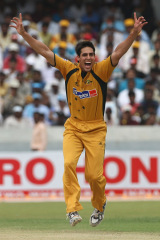Johnson peaks at perfect time
Mitchell Johnson confirms he is a star on the rise with his maiden five-wicket haul in ODIs
Brydon Coverdale
11-Oct-2007
|
|

|
The Mitchell Johnson ball that dismissed Mahendra Singh Dhoni was an ideal delivery to a left-hander - it pitched on an awkward length, moved away off the seam and drew the batsman into a stroke. Unfortunately Dhoni is a right-hander. It didn't matter; Dhoni tried to fend the ball to the leg side and feathered it to Adam Gilchrist. Johnson's third wicket had come with one of his least dangerous balls of the innings. Sometimes it's just your day.
And that is fair enough, as Johnson has endured plenty of occasions when it hasn't been his day. He was no more than a footnote in Australia's Ashes and World Cup triumphs; now he seems intent on writing his own chapter in Australian cricket's future. His 5 for 26 on what most experts tipped as a belter at Vadodara confirmed what good judges have been saying for years - Johnson is a star on the rise.
He hurtled through the Indian middle order after two wickets fell in Brett Lee's opening over and finished with the best figures by an Australian in an ODI in India. He was quick, although the slowish pitch didn't let him reach top speed, but it was his control and single-minded objective to keep collecting victims that impressed the most.
Johnson shone in the World Twenty20 and used the opening four games in India to build to this crescendo. The timing of his form spike is impeccable. Australia's home campaign begins in less than a month with a Test against Sri Lanka at Brisbane. Johnson knows the Gabba well and he has a compelling argument for a home Test debut, especially with Shaun Tait still recovering from elbow surgery.
Should the selectors agree, Johnson will at least be familiar with the process. He spent all five Ashes Tests last summer as Australia's 12th man, watching as Lee, Glenn McGrath and Stuart Clark carried the pace attack in the whitewash. That was followed by an extended holiday in the Caribbean as he became a spectator in another cleansweep, overlooked for every match.
Lest anyone mistake him for one of the support staff due to his permanent place in the dressing-room, Johnson took another overseas trip during Australia's off-season to bolster his armoury at the MRF Pace Foundation in Chennai. The work began to pay off in South Africa, where he took eight economical Twenty20 wickets.
The challenge will be to transfer his form into the Test arena if the opportunity arises. While Tait and Clark have both been used at Test level, the selectors for a long time kept Johnson ahead of that handy pair in the ODI squad. His first limited-overs five-wicket haul has shown there was reason behind their faith. Johnson was especially troubling against India's left-handers, controlling his outswing and subtle movement off the pitch and enticing edges behind from Yuvraj Singh, Irfan Pathan and Murali Kartik.
His simple system also worked against the right-handers, as Robin Uthappa found when he was trapped lbw by a ball that angled across him and straightened sharply. Johnson's dominance was especially impressive on a red, dusty pitch that wouldn't have looked out of place in the Australian outback. His speed was still lively - he hovered in the low 140kph region - and he persistently banged the ball hard in the right areas.
It helped having a dangerous companion at the other end. Lee has made a terrific comeback from the serious ankle injury that kept him out of the World Cup. With the retirement of McGrath, he is now Australia's No. 1 strike bowler. His outswing has been masterful this series, especially at Chandigarh where he initially made Sachin Tendulkar look clueless. Lee is still capable of pushing into the upper 150kph vicinity but at Vadodara he proved his danger at a lower velocity. Rahul Dravid fell to a straight one that rapped his pads and left India 5 for 2; later Tendulkar edged a perfect outswinger to Gilchrist for 47.
With Tait, Clark and the promising Ben Hilfenhaus also competing for places, the initial signs from Lee and Johnson bode well for the post-McGrath period. This time they were helped by some sharp, age-defying wicketkeeping by Gilchrist, who also muscled into batting form with 79 - including three clean sixes off one Kartik over - as Australia cruised to the target of 149.
Lee and Gilchrist contributed a couple of chapters but the chief author of this success story was Johnson, who Dennis Lillee described nearly a decade ago as a "once in a generation bowler". Since that time Johnson has been pencilled in to Australia's long-term plans. At last he has started writing his tale - boldly, and in permanent marker.
Brydon Coverdale is an editorial assistant on Cricinfo